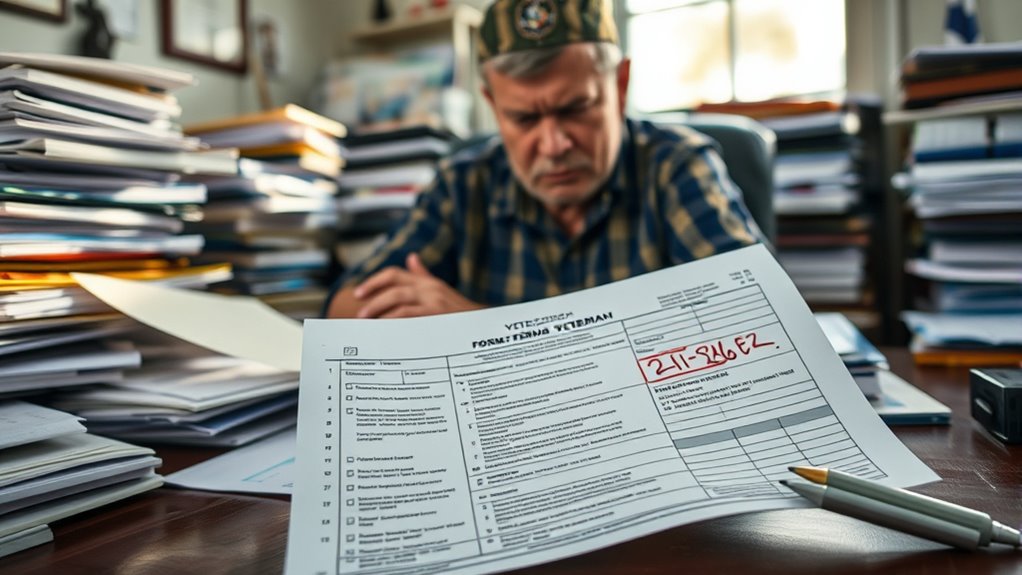One common mistake veterans make on Form 21-526EZ is providing incomplete or vague disability details, which can delay processing. Many forget to include supporting medical records or fail to clearly explain how disabilities affect daily life. Using vague medical jargon instead of simple language also causes confusion. Accurate, detailed information is key, and ensuring all evidence is organized before submission helps avoid delays. Keep going to see how you can avoid these pitfalls entirely.
Key Takeaways
- Failing to clearly specify each service-connected disability with accurate dates and impact details.
- Using vague medical language instead of clear, straightforward descriptions of symptoms.
- Omitting critical supporting documents like medical records and nexus letters.
- Making errors in personal information, dates, or signatures on the form.
- Not reviewing the form thoroughly or seeking guidance before submission.

Applying for veterans’ benefits can be a crucial step toward securing the support you deserve, but many veterans make common mistakes on Form 21-526EZ that can delay or jeopardize their claims. One of the most critical aspects of this process involves properly handling disability claims. If you don’t provide complete and accurate information, your claim may be delayed, denied, or require additional evidence, prolonging your wait for benefits. The VA disability process relies heavily on the details you submit, so taking the time to fill out the form correctly is essential.
A frequent mistake is leaving out important details about your service-connected disabilities. You need to clearly identify each condition, include relevant dates, and specify how these disabilities impact your daily life. Vague descriptions or incomplete information can cause the VA to question the legitimacy of your claims or request further clarification, which slows down the entire process. Be thorough and honest when listing your disabilities, and double-check that all supporting documentation is attached before submitting the form.
Another common error involves improper or inconsistent use of terminology. Using medical jargon or vague language can lead to confusion and misinterpretation by VA reviewers. Instead, stick to clear, straightforward descriptions that accurately reflect your condition. If you’re unsure about medical terms or how to describe your symptoms, consider seeking help from a representative or veteran service officer who can guide you in completing the form correctly.
Use clear, simple language to accurately describe your condition and avoid medical jargon.
Many veterans also overlook the importance of including all relevant evidence from the start. The VA disability process depends heavily on supporting documentation, such as medical records, service treatment records, and nexus letters linking your disability to your service. Failing to submit thorough evidence initially may result in a denial or a lengthy back-and-forth requesting additional information. Gathering and organizing your evidence before submitting your claim can save you significant time and frustration.
Additionally, understanding how specialized evaluations and proper documentation influence the success of your claim can make a substantial difference in the outcome.
Lastly, some veterans neglect to review their completed form thoroughly before submission. Mistakes like misspelled names, incorrect dates, or missing signatures can cause delays or even rejection of your claim. Take the time to review everything carefully, ensuring all sections are complete and accurate. If possible, have someone else review your form as well, to catch errors you might miss.
Frequently Asked Questions
How Can I Correct a Mistake After Submitting Form 21-526EZ?
If you realize you made a mistake after submitting your Form 21-526EZ, you need to act quickly to correct your submission. You can do this by submitting an amending application through the VA’s website or mailing a corrected version. It’s important to clearly identify the errors and provide the correct information. Contact the VA if needed to ensure your correction is processed smoothly and your claim stays on track.
What Are Common Reasons for Claim Denial Besides Mistakes?
When your claim gets denied, it’s often due to issues during claim processing, not just mistakes on your form. Sometimes, insufficient evidence or missing documentation can hinder veteran benefits approval. You might also face denial if your service records don’t support your claim or if the VA determines your condition isn’t service-connected. Always review the reason for denial carefully and provide additional evidence to strengthen your case for better chances of approval.
Is There a Way to Expedite My VA Disability Claim?
If you want to expedite your VA disability claim, you should explore options like VA Fast Track or submitting a request for expedited processing. You can qualify if your situation involves urgent medical issues, financial hardship, or if you’re seriously ill. Make sure to clearly document your reasons and provide supporting evidence. Contact your VA representative or use the online tools to help guarantee your claim moves through the process faster.
How Does Recent Military Service Impact My Application?
Recent military service influences your application by highlighting your discharge status and service separation. If your discharge was honorable, it supports your claim, while a less-than-honorable discharge might require additional evidence or explanations. Your service separation details help VA determine your eligibility and benefits. Clearly documenting your recent military service guarantees the VA accurately assesses your claim, making the process smoother and increasing your chances of approval.
What Documentation Is Required if My Circumstances Change?
When your circumstances change, you need to provide documentation updates and supporting evidence to keep your claim accurate. This might include new medical records, proof of additional service, or updated personal information. Make sure to submit these documents promptly to avoid delays. Keeping your records current helps VA process your application smoothly, ensuring you receive the benefits you’re eligible for without unnecessary setbacks.
Conclusion
By avoiding common mistakes, double-checking your information, and understanding each step, you can streamline your claim process. Don’t overlook details, don’t rush through sections, and don’t assume everything is correct. Instead, review carefully, verify thoroughly, and stay informed. Taking these simple but essential actions ensures your application is complete, accurate, and timely. Remember, attention to detail, patience, and diligence are your best tools for a smooth and successful VA claim.











